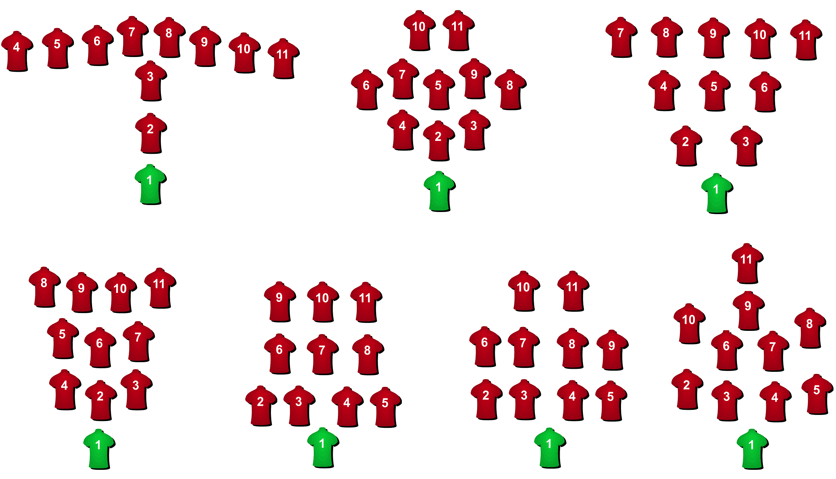 During football’s more formative years, the links to the sport of rugby were inescapable. As the two different disciplines diverged from each other, football began to find its feet and become its own game, but that wasn’t the case immediately.
During football’s more formative years, the links to the sport of rugby were inescapable. As the two different disciplines diverged from each other, football began to find its feet and become its own game, but that wasn’t the case immediately.
The evolution of football as a sport can perhaps be best tracked by looking at the way that formations have changed.
Initially football formations and those used in rugby were closely linked, with players mostly running as a unit and charging down the opposition. As the game became more sophisticated, so too did the formations that were used.
It is, of course, an ever-changing beast, but here’s a look at the early days of football formations and how they’ve changed over the years.
Major Football Lineup Changes
| Dominant Formations | Years | Major Influence |
|---|---|---|
| 1-1-8, 1-2-7, 2-2-6 | 1860’s – 1880’s | Rugby |
| 2-3-5 | 1880’s – 1925 | Scottish Passing Game |
| 3-3-4 | 1925 – 1950’s | Offside |
| 4-2-4, 4-3-3 | 1950’s – 1970’s | Countering 3-3-4 |
| 4-4-2, 5-4-1 | 1970’s – 1990’s | Italian Defensive Game |
| 3-5-2, 5-3-2 | 1990’s – 2000’s | In Game Formation Changes |
| Variable Formations | 2000’s – Present Day | Fluid Formations Changing On Situation |
The Early Years
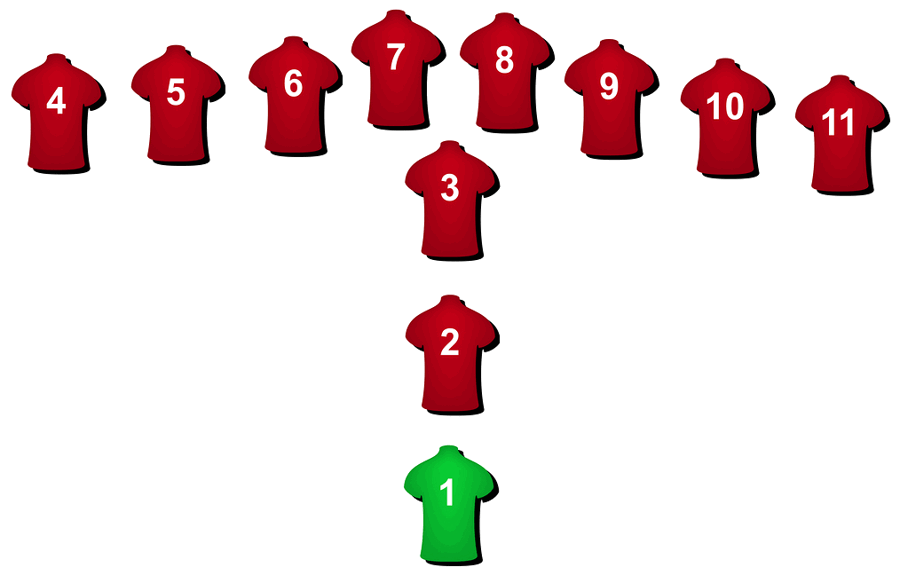
When football was first being created as a sport, the idea of trying to defend seemingly didn’t enter anyone’s mind. The sport was an immediately attacking one, with the most common formation used being that of 1-1-8. For a modern football team to even consider playing with just one defender and one midfielder is equitable to conceding the game.
Back when it was first starting, however, it wasn’t unheard of. When England played Scotland in the first ever international match in 1872, for example, England went with a combination of 1-1-8 and 1-2-7 at different times, whilst Scotland opted for a 2-2-6 formation. England depended on individual excellence, but Scotland used the team to their advantage and played a passing game.
Given the game contained a combined total of fourteen forwards, it is somewhat surprising that the match ended 0-0. In part this is because passing wasn’t yet seen as an important or admirable part of the sport. There’s a good chance that the English players wondered what on earth their Scottish counterparts were up to.
Passing wasn’t initially something that the fans, journalists or even players admired or thought was essentially to the way football was played. Instead, the game was more about individual player’s skills and dribbling, meaning that a small defence could tackle the players that were dribbling the ball.
Things Begin To Change
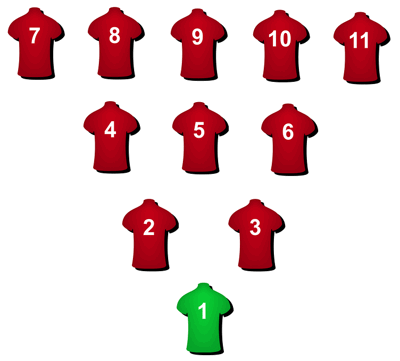 In the book Association Football, which was published by Caxton in 1960, there is a report suggesting that the Welsh Cup was won by Wrexham in 1877 when the side played ‘three half backs and five forwards’ in a 2-3-5 formation. It wasn’t officially recognised until 1880, but it began to signal a major shift in the way that football teams played the game.
In the book Association Football, which was published by Caxton in 1960, there is a report suggesting that the Welsh Cup was won by Wrexham in 1877 when the side played ‘three half backs and five forwards’ in a 2-3-5 formation. It wasn’t officially recognised until 1880, but it began to signal a major shift in the way that football teams played the game.
It was known as the pyramid and was seen as a formation that offered a balance between attacking and defending. The fullbacks were responsible for covering the wingers of the opposition team, whilst the halfbacks, or midfielders, watched the opposition’s most attacking players. They would also act as a linking unit between defence and attack.
Despite being so hugely different to the modern day game, the formation put in place the building blocks that are still used today. The centre halfback was responsible for tracking the other side’s most creative player, their centre forward. They would receive the ball at the back and look to get it to the forwards as quickly and efficiently as possible.
The Scottish Invasion
 During the 1880s the likes of William Sudell and Tom Mitchell began to bring players down from Scotland to play for their teams Preston North End and Blackburn Rovers. They used the Scottish players to introduce a more passing-focussed style and became very successful as a result. Never was this clearer than during the first season of the Football League.
During the 1880s the likes of William Sudell and Tom Mitchell began to bring players down from Scotland to play for their teams Preston North End and Blackburn Rovers. They used the Scottish players to introduce a more passing-focussed style and became very successful as a result. Never was this clearer than during the first season of the Football League.
The Football League’s inaugural season began in 1888 and Preston North End, under the leadership of William Sudell, won the championship without losing a game. That earned the club the nickname ‘The Invincibles’ and changed the way other managers and teams thought about the sport. It helped that they also beat Wolverhampton Wanderers to win the 1889 FA Cup.
Soon other teams began to use the same 2-3-5 formation, as well as bringing players down from Scotland to develop their passing game. It was one of the biggest changes to football as we know it, remaining the dominant formation in the sport until 1925. That was the year that the Football Association decided to introduce a rule that would change everything.
Offside Shifts The Focus Of Football
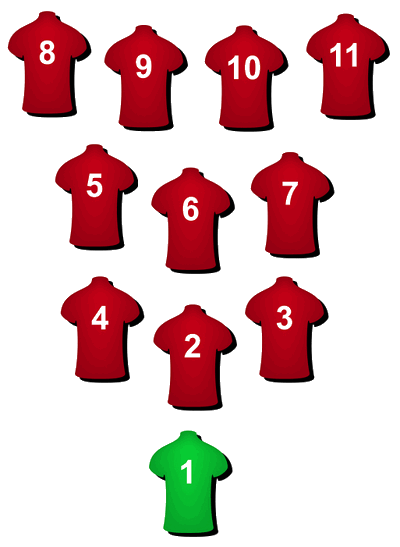 In 1925 the Football Association chose to introduce the offside rule. This immediately altered the number of attacking players that a team could look to use, as well as altering the number of attacking players between a forward and the goal. Charlie Buchan, an Arsenal player, spoke to the club’s manager, Herbert Chapman, and suggested the new rule could be exploited.
In 1925 the Football Association chose to introduce the offside rule. This immediately altered the number of attacking players that a team could look to use, as well as altering the number of attacking players between a forward and the goal. Charlie Buchan, an Arsenal player, spoke to the club’s manager, Herbert Chapman, and suggested the new rule could be exploited.
Buchan felt that the centre-half should lead the offside trap, with the overall formation of the team changing from 2-3-5 to 3-3-4. Sometimes referred to as the WM formation, it was the catalyst for what we’d nowadays call a counter-attacking style. It took time for the formation to be perfected, but when it was it led to great success for Arsenal.
They won the FA Cup in 1930, but it was the following season when the club’s change in fortune as a result of this new formation truly led to glory. The Gunners won the First Division championship for the first time and would likely have done so the following season had Alex James, the team’s passing genius, not been injured seeing them miss out by two points.
Missing out to Everton might well have been the catalyst for Arsenal’s decision to double down their efforts, winning the season in 1933 and 1934, scoring a club record number of goals in the first of those two campaigns. Unsurprisingly, the WM formation had become popular throughout the Football League as a result of Arsenal’s success.
Modern Formations Take Shape
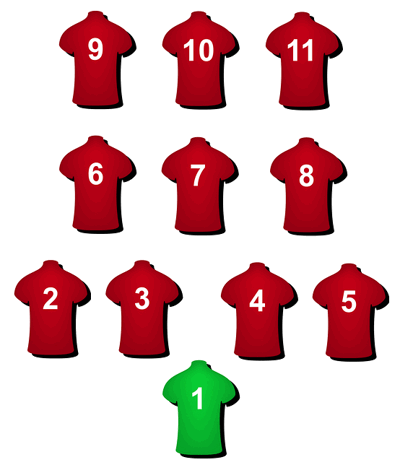 The drive behind the creation of more modern formations came about as a direct result of clubs trying to find a way to counter the 3-3-4 WM formation that Arsenal and others had enjoyed such success with. Indeed, that remained the dominant formation in most of Europe until 1950. That was the point at which Gusztáv Sebes came up with something different.
The drive behind the creation of more modern formations came about as a direct result of clubs trying to find a way to counter the 3-3-4 WM formation that Arsenal and others had enjoyed such success with. Indeed, that remained the dominant formation in most of Europe until 1950. That was the point at which Gusztáv Sebes came up with something different.
His idea was to change formations during the game depending on the circumstance; something that seems remarkably simply nowadays but that was revolutionary in its own way. The centre-forward would come back and support the offensive midfielders, with those middle men using pace to help him in return and the 4-2-4 formation was born.
The Brazilians then evolved things even further and created the first of the formations that continues to be used today, 4-3-3. A far cry from what the football journalist Jonathan Wilson wrote in his book Inverting The Pyramid as ‘chaos’ from the days when ‘football had no shape’. Inverting The Pyramid was also an appropriate title for what happened in the game.
The 4-3-3 formation, which was the first one that didn’t utilise wingers, was used to great success by England in the 1966 World Cup. The home nation would eventually go on and win the tournament, switching between 4-3-3 and their more default formation that was closer to 4-1-3-2 as we’d call it nowadays.
Things Become Defensive
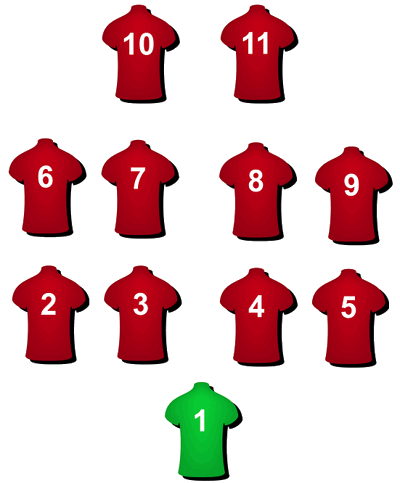 After spending most of the early years of the game thinking it was all about attacking, the switch to a far more defensive frame of mind was rapid. Nowadays Italians have a reputation for being defensively-minded and that is probably down to Inter Milan coach Helenio Herrera. He was one of the first to move his team to become ultra-defensive in its play.
After spending most of the early years of the game thinking it was all about attacking, the switch to a far more defensive frame of mind was rapid. Nowadays Italians have a reputation for being defensively-minded and that is probably down to Inter Milan coach Helenio Herrera. He was one of the first to move his team to become ultra-defensive in its play.
He introduced the 5-4-1 formation to the world, which soon became the standard for Italian football. It was the formation used by the Italian national team when they won the silver medal at the World Cup in 1970. Meanwhile, Swedish clubs like IFK Gothenburg and Malmo FF began to use the 4-4-2 formation, which is more commonly attributed to Russian Viktor Maslov.
It’s interesting that Russians and Swedes lay claim to the formation when you consider that it is mostly thought of as being a stereotypically British formation nowadays. It is a way of playing that puts the emphasis on collective strategy, asking players to work hard to cover as much of the pitch as possible and move the ball at speed.
Attacking Returns
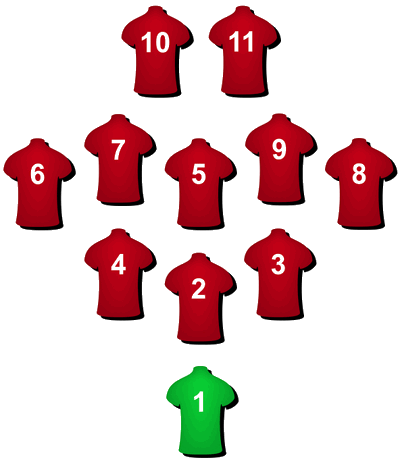 In 1990 West Germany won the World Cup by mostly using a 3-5-2 formation. This is one that puts the stress of good play onto individual skill rather than a team mentality.
In 1990 West Germany won the World Cup by mostly using a 3-5-2 formation. This is one that puts the stress of good play onto individual skill rather than a team mentality.
It remains a popular formation in the modern game, in spite of the fact that it was quite a divisive one when it was first introduced.
Some believe that it was invented in the 1950s by Dinamo Zagreb coach Miroslav Blažević.
The position of the players can be altered in any formation, with 3-5-2 being the quintessential example. If a team has the full-backs push high up the pitch then it will be 3-5-2, whereas if they sit back and support the central defenders it will be more like 5-3-2. It’s why individual ability is so important to the formation’s success, especially in the case of the full-backs.
Modifying Formations
 The reality of formations used on a football pitch is that no single one of them is ‘perfect’. Circumstances will dictate which formation will be the right one to use, as well as the fact that the players used in a team will suit certain formations over others. The opposition will also be a key factor in dictating a formation that a manager chooses to use.
The reality of formations used on a football pitch is that no single one of them is ‘perfect’. Circumstances will dictate which formation will be the right one to use, as well as the fact that the players used in a team will suit certain formations over others. The opposition will also be a key factor in dictating a formation that a manager chooses to use.
Managers have long been experimental with their formations, which is part of what makes football so interesting. It’s also worth noting that there is such a fine line between various formations. What is it that means a team is playing 4-2-3-1 rather than 4-4-2, for example? What sees 4-5-1 differ from 4-1-4-1? Both formations pack the midfield, after all.
Even settled formations like 4-4-2 that have been around for decades can still be tweaked. The 4-4-2 diamond, for example, sees one member of the midfield support the defence and the other work closer to the attack, with the extra middle men pushed wide. Whilst teams can obviously also change their formation mid-match, the reality is that managers can only really work with a couple of formations, such is the difficulty to implement them.
It is this shifting from one formation to another and the tweaking of formations that already exist that makes football such a fascinating sport to watch. It’s also what allows it to forever re-invent itself as a game, with the one that we play and watch today bearing almost no resemblance to the sport that it was when it was first invented.
